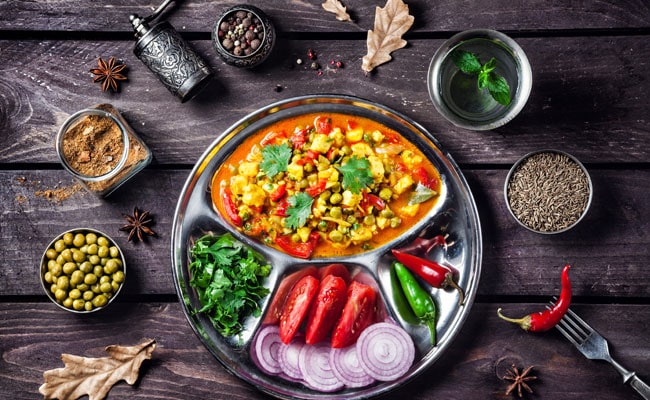Let us celebrate the Ancient wisdom of India – the “Ayurveda (The Knowledge of Life)” through its food concepts on the eve of the 7th Ayurveda day 2022 (23rd October 2022) announced by the Ministry of Ayush, Government of India
What is Ayurveda Aahara?
Ayurvedic Aahara are traditional foods of healing nature that are formulated using the recipes from the ancient Ayurvedic texts. The healing nature of these foods is attributed to its components, which are combined in a way to balance the five elements (Space, Air, Fire, Water & Earth) in our body. The imbalance of these elements causes disturbance in body functions. The ayurvedic dietary recommendations, medicinal remedies and lifestyle helps in balancing these elements in the body in resonance with nature, thereby maintaining good health. The Ayurveda Aahara also includes the Pathya aahara (ie. foods that are specified for consumption during or post specified diseases & disorders).
The dietary recommendations are made according to the individual’s body constitution – Vata (Space & Air), Pitta (Fire & Water) and Kapha (Earth & Water).
Ayurvedic Foods for you
Halu kashaya, Jaljira powder juice, Nannari sharbat, Tambuli, Ondelega chutney, Neem flower chutney (Veppampoo thuvaiyal), Bamboo shoot curry (kalale sambar), Koove hittu (Tikhur), Bakhar Herbal rice drink (with churna of Terminalia arjuna), are some Ayurvedic food preparations. There are ayurvedic foods recommended for people with conditions like diabetes, osteoporosis, etc.
How do you know it is Ayurveda Aahara?
There are numerous books on Ayurveda Aahara, namely, Abhinava Chintamani, Ashtanga Hridaya, Ayurveda Samgraha, Ayurvedic Pharmacopoeia of India, Charak Samhita, Rasa Pradipika, Rasamanjiri, Sahasrayoga, Siddha Yoga Samgraha, Sushruta Samhita, Vaidya Chintamani, Yoga Chintamani etc. FSSAI lists out 71 books on Ayurveda that can be used for preparing Ayurveda Aahara. These books reveal the food habits of our ancestors from Vedic period.
An immense knowledge rests in these books to be unveiled by the passionate food enthusiasts/ entrepreneurs who should take this as an opportunity to present this rich ancient wisdom to the common man.
What does FSSAI say about Ayurveda Aahara?
According to the Food Safety and Standards Authority of India, Ayurveda Aahara means a food that is prepared in accordance with the recipes or ingredients or processes as per method described in the authoritative books of Ayurveda.
For example, here the recipe for a kind of meat preparation (Vesavara) from the ancient Ayurvedic book (Susruta Samhita) is described thus. Meat devoid of bone, cooked by steam, made into a paste, adding pippali (long pepper), sunthu (dry ginger), marica (pepper), guda (jaggery) and sarpi (ghee) mixed well and all cooked together; this is known as Vesavara. It is hard for digestion, unctuous, strengthening and curing diseases of Vata origin.
Ashtanga Hridaya by Vagbhata, describes the method of preparation of Panchamrith – a sacred Ayurvedic preparation made of sour curd, rock sugar (mishri), honey, ghee, dry ginger powder, pepper powder and jeera powder and that is expected to help in balance the Tridosha.
These Ayurvedic recipes can benefit people, and Food Business Operators can make these foods available to the consumers in suitable packaged formats that preserves its benefits. The potential for Ayurvedic foods in both the Indian and International markets is still unexplored. The foods that are industrially manufactured and packed according to ayurvedic recipes may also considered as Ayurveda Aahara, provided that the foods retain the same quality & characteristics of food as specified in the Ayurvedic texts. The exception being, ayurvedic drugs or proprietary Ayurvedic medicines, cannot be considered as Ayurveda Aahara. Food Safety and Standards Authority of India has laid down regulatory requirements for Ayurveda Aahara and the foods that are manufactured, packed, sold, marketed, distributed or imported as Ayurveda Aahara must conform to these regulations [Food Safety and Standards (Ayurveda Aahara) Regulations, 2022] of FSSAI. These foods should have this logo on the front of the pack of their labels.

FSSAI requirements of Ayurveda Aahara?
Here are the things to take care of before calling Ayurveda Aahara
- The Ayurveda Aahara should not be administered to infants upto the age of 24 months and it should not have added vitamins, minerals & amino acids, other than those naturally present.
- The ingredients used in the preparation Ayurveda Aahara should meet the purity criteria as specified in FSSAI regulations or Indian Pharmacopoeia, Ayurvedic Pharmacopoeia of India, British Pharmacopoeia, United States Pharmacopoeia or relevant BIS Specifications, or Quality Standards of Indian Medicinal Plants as published by Indian Council of Medical Research.
- The regulatory requirements differ for different categories of Ayurveda Aahara as described by FSSAI. Only the permitted additives in the Ayurveda Aahara regulations shall be used.
- All Ayurveda Aahara products must meet the required microbiological standards & contaminant levels as specified in these regulations. Additionally, it shall comply with the Packaging, Labelling & Display and Advertising & Claims regulations.
Ayurvedic Aahara are not something very different from what you might already be eating. Here are some Ayurveda recipes from Susrutha Samhitha that are similar to some commonly relished foods of our times. Madhumastaka, Samyava and Vatakaare are savoury like snack preparations.
- Madhumastaka is dough made into thin discs, lump of sugar, ghee, etc. are kept inside, enveloped all around and cooked (in steam).
- Samyava is dough added with milk, sugar, etc. kneaded well made into thin discs, cooked (deep fried) in ghee, then powder of sugar candy, ela, marica and adraka are sprinkled over it.
- Vataka (Vada) are flat, round discs made from thick paste of pulses added with vegetables and spices and deep fried in oil and consumed warm as snacks.
- Payasa is a common sweet dessert. It is a milk pudding, a mixture of boiled rice and milk added with sugar or jaggery) that stays long in the stomach, bestows strength, increases fat and Kapha and is hard for digestion.
- Krsara is a thick gruel prepared by boiling tila (sesame), tandula (rice) and masa (black gram), increases kapha and pitta, mitigates vata and bestows strength.
It is time to bring back some of the goodness of the ancient knowledge back into our lives and diet. Simply put “Let food be thy medicine and medicine be thy food”.

Author: Mythri R is an Associate Consultant at Food Safety Works. She has been working with a lot of food processing units to ensure they have a robust Food Safety Management System. She is very well conversant with HACCP and ISO22000.



